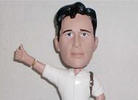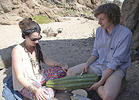
"Spread those knees and let's smoke some weed," Dean Moriarty tells his young wife Marylou in On the Road. Jack Kerouac's landmark novel has finally been adapted into a movie.
Directed by Walter Salles (The Motorcycle Diaries), On the Road stars Sam Riley (Sal Paradise) and Garrett Hedlund (Moriarty) as stoner buds who race around the country in the late '40s and early '50s in an existential fever dream. Dean's gal, played by the winsome Kristen Stewart, comes along for part of the ride.
Kerouac's post-WWII saga was about the new generation of seekers who went against the grain: jazz-loving, free-loving, drug-taking Bohemians on a mission to shake up America. Kerouac's Sal and Neal Cassady's Dean are the archetypal best friends who feed off each others' energy - in the case of Dean, a highwire sort of energy bordering on dangerous that Sal finds intoxicating. As they both find Marylou, the sweet little thing in the front seat.
Not a lot happens in On the Road. There's no big story arc, just plenty of miles staring down the blacktop highway. They hang out with writer friends like the gay Carlo Max (Tom Sturridge as Allen Ginsberg) and the heroin-addicted Bull Lee (Viggo Mortensen as William S. Burroughs). When not literally "on tithe road," the story takes place in New York, San Francisco, New Orleans and Denver, where Dean lives. They all criss-cross the country visiting and feeding off each other. Dean and Sal share Marylou until Dean meets Camille (Kirsten Dunst as Carolyn Cassady) and settles down with her. Marylou splits mid-story, which is too bad because she's a lively presence in the movie, as opposed to the dour Camille.
Unlike John Byrum's Heartbeat, which covers similar territory, Salles' On the Road buries the tension between Kerouac and Cassady. In Heartbeat, Carolyn Cassady was at the center of the love triangle, creating jealousies that the guys could never quite overcome. Only near the end of On the Road is it clear that the relationship between Sal and Dean had run its course. But mostly it's a loving portrait of an era long gone by, when hopping a freight train was a standard mode of transportation and typewriters were the means of production for the creative literary spirit.
This may not be the perfect version of On the Road, but thankfully the book that shook up the nation in 1957 has, after many years of trying, at last made it the silver screen.






